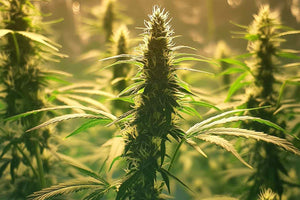In modern horticulture, LED lights have become the best light source for plant growth. However, with so many types of LED lights on the market, how do you choose the one that best suits your plants? Today, we will explore what kind of LED lights are most suitable for plant growth and help you create an efficient and healthy plant-growing environment.
1.Types of LED Lights Suitable for Growing Plants
Among the many types of LED lights, full spectrum LED lights and specific wavelength LED lights are the best options for plant cultivation.
1)Full Spectrum LED Lights

Full spectrum LED lights mimic natural sunlight, covering almost all the spectrums needed for plant growth. They are suitable for all types of plants, whether they are vegetables, flowers, or succulents.
This avoids the need to frequently change lights, as they can meet the light needs during all growth stages, making the growing process simpler.
2)Specific Wavelength LED Lights
Specific wavelength LED lights mainly refer to red and blue LED lights, UV/FR LED bars, etc.
Red and Blue LED Lights: Red light is mainly used to promote flowering and fruiting, while blue light promotes the growth of stems and leaves. These are suitable for vegetable plants and flowers during their mid-to-late growth stages.

UV/FR LED Bar: UV enhances the plant's resistance to disease, while FR (Far Red) promotes flowering. This type of light is suitable for the late flowering and fruit maturation stages of plants that need to boost yield and quality, such as cannabis and tomatoes.
2.Key Factors When Choosing LED Lights
When selecting LED lights suitable for growing plants, there are several key factors to consider:
1)Matching the Plants Needs with the Spectrum Range
The spectrum needs of plants vary by type, so understanding the specific requirements of your plants is a crucial first step. A good grow light should be able to provide a complete full spectrum, including blue light (wavelength 400-500 nm), red light (wavelength 600-700 nm), and a small amount of far-red light (wavelength 700-800 nm).
2)Light Output (PPF and PPFD)
Photosynthetic Photon Flux (PPF) indicates the number of photons produced by the light source per second.
Photosynthetic Photon Flux Density (PPFD) is the actual number of photons received by the plant. These indicators determine the light intensity, and the LED lights should provide enough light to meet the photosynthesis needs of the plant. For example, cannabis during its growing phase requires 700-900 µmol/m²/s, so the PPFD of the LED lights should reach at least 900 µmol/m²/s.
3)Energy Efficiency and Heat Dissipation
Energy efficiency and heat dissipation are important factors when choosing grow lights. High-efficiency grow lights not only reduce electricity costs but also require less attention to heat management during prolonged use. Aluminum heat sink grow lights perform better in heat dissipation.
4)Dimmable Function
Most grow lights now come with an automatic dimming function that allows you to adjust the light intensity according to the plant's needs, helping plants grow more healthily.
5)Lifespan and Cost Efficiency
Choosing long-lasting and reliable LED lights may require a higher initial investment, but in the long run, it reduces the frequency of replacements and maintenance, resulting in higher cost efficiency.
3. Applications of LED Lights in Different Plant Cultivation
1)Vegetables
Vegetables such as tomatoes and cucumbers require high light intensity, especially during growth and fruiting stages. Full spectrum LED lights or red and blue LED lights can promote fast growth and high yields.
2)Flowers
Flowering plants like roses and orchids have more delicate light spectrum requirements. Red light helps flowers bloom and enhances color vibrancy, while blue light promotes healthy stem and leaf growth. Red and blue LED lights are a better choice for flower cultivation.
3)Succulents and Indoor Decorative Plants
Succulents and indoor decorative plants have relatively lower light requirements but still need sufficient light to stay healthy. Full spectrum LED lights are a good choice, providing just the right amount of light and adjusting according to the plant's stage and season.
4)Cannabis
For cannabis cultivation, adjustable full spectrum LED grow lights are an excellent option, suitable for all stages of plant growth.
4.How to Optimize the Use of LED Lights
1)Setting the Light Cycle Properly
setting the light cycle to simulate natural lighting conditions helps plants grow normally. In general, plants need 12-16 hours of light during the growth phase, while less light is needed during the resting phase, depending on the type of plant.
2)Adjusting the Distance Between Lights and Plants
The distance between LED lights and plants should generally be maintained at 30-60 cm. Adjust based on light intensity and the needs of the plant to ensure even lighting without being too strong. You can refer to the manufacturer's recommendations for specific distances.
3)Other growth factors
In addition to light, temperature, humidity, and nutrients are also important. Ensure the use of LED lights in suitable temperature and humidity environments, and fertilize reasonably to keep plants in their best condition.

